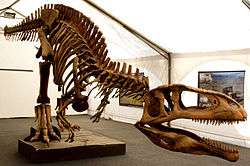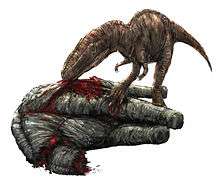Tyrannotitan
| Tyrannotitan Temporal range: Early Cretaceous, 118 Ma | |
|---|---|
 | |
| Mounted skeleton | |
| Scientific classification | |
| Kingdom: | Animalia |
| Phylum: | Chordata |
| Class: | Reptilia |
| Clade: | Dinosauria |
| Order: | Saurischia |
| Suborder: | Theropoda |
| Family: | †Carcharodontosauridae |
| Tribe: | †Giganotosaurini |
| Genus: | †Tyrannotitan Novas et al., 2005 |
| Species | |
| |
Tyrannotitan is a genus of huge bipedal carnivorous dinosaur of the carcharodontosaurid family from the Aptian stage of the early Cretaceous period, discovered in Argentina. It is closely related to other giant predators like Carcharodontosaurus and especially Giganotosaurus as well as Mapusaurus. The name means "Tyrant titan".
Description


Tyrannotitan is the geologically oldest known giant carcharodontosaurid along with the more basal Acrocanthosaurus from North America (both found in Aptian-age rocks[1][2]). Unlike known carcharodontosaurids, this animal lacks pneumaticity extending into the sacral and caudal centra. The scapulocoracoid is fused, and much better developed than that of Giganotosaurus carolinii, yet the arm is very small. Most of the shaft of the scapula is missing.
The acromion curves about 90 degrees from the shaft axis, making it look vaguely tyrannosaurid-like. Whether the sharp difference between taxa is due to evolution or sexual dimorphism in poorly sampled populations of both species, has not been determined (the latter seems unlikely). A proximal caudal has a very tall neural spine (about twice the height of its centrum, judging by the figure). The base of the orbital fenestra is a notch of nearly 90 degrees into the body of the jugal, which contrasts with the rounded base restored for Giganotosaurus and agrees with Carcharodontosaurus favorably. The denticles on its teeth are "chisel-like", and are virtually identical to those of other carcharodontosaurids in having a wrinkled enamel surface, heavily serrated mesial and distal carinae, and labiolingually compressed (laterally flattened) crowns.[3] The femur of the paratype specimen is 1.40 meters long according to Novas et al. Canale et al. recover Tyrannotitan as deeply nested within the tribe Giganotosaurini as its most basal member. Characters that unite the Giganotosaurini include the presence of a postorbital process on the jugal with a wide base, and a derived femur with a weak fourth trochanter and a shallow broad extensor groove at the distal end [3][4]
Discovery and species

Tyrannotitan chubutensis was described by Fernando E. Novas, Silvina de Valais, Pat Vickers-Rich, and Tom Rich in 2005.[5] The fossils were found at La Juanita Farm, 28 kilometres (17 mi) northeast of Paso de Indios, Chubut Province, Argentina. They are believed to have been from the Cerro Castaño Member, Cerro Barcino Formation (Aptian stage) around 112.2 - 121 million years ago.
The holotype material was designated MPEF-PV 1156 and included partial dentaries, teeth, back vertebrae 3-8 and 11-14, proximal tail vertebrae, ribs and chevrons, a fragmentary scapulocoracoid, humerus, ulna, partial ilium, a nearly complete femur, fibula, and left metatarsal 2.
Additional material (designated MPEF-PV 1157) included jugals, a right dentary, teeth, atlas vertebra, neck vertebra (?) 9, back vertebrae (?)7, 10, 13, fused sacral centra (5 total), an assortment of distal caudals, ribs, the right femur, a fragmentary left metatarsal 2, pedal phalanges 2-1, 2-2, and 3-3.
The length of these animals has been estimated at up to 11.4–12.2 metres (37–40 ft).[6][7] In 2010, Gregory S. Paul gave higher estimations of 13 metres (43 ft).[8] Its weight has been estimated between 4.9 and 7 tonnes (5.4 and 7.7 short tons).[2][8]
The following cladogram after Novas et al., 2013, shows the position of Tyrannotitan within Carcharodontosauridae.[9]
| |
| ||||||||||||||||||||||||||||||||||||||||||||||||
| |
References
- ↑ "Bates KT, Manning PL, Hodgetts D, Sellers WI (2009) Estimating Mass Properties of Dinosaurs Using Laser Imaging and 3D Computer Modelling. PLoS ONE 4(2): e4532. doi:10.1371/journal.pone.0004532".
- 1 2 "Nicolás E. Campione, David C. Evans, Caleb M. Brown, Matthew T. Carrano (2014). Body mass estimation in non-avian bipeds using a theoretical conversion to quadruped stylopodial proportions. Methods in Ecology and Evolution. doi:10.1111/2041-210X.12226".
- 1 2 "Canale, J.I, Novas, F.E, Pol, D. (2015) : "Osteology and phylogenetic relationships of Tyrannotitan chubutensis Novas, de Valais, Vickers-Rich and Rich, 2005 (Theropoda: Carcharodontosauridae) from the Lower Cretaceous of Patagonia, Argentina" ; Historical Biology, Volume 27, Issue 1, 2015, pages 1- 32 Published online: 27 Oct 2014 DOI: 10.1080/08912963.2013.861830".
- ↑ "Coria R. A. & Currie P. J. 2006. — A new carcharodontosaurid (Dinosauria, Theropoda) from the Upper Cretaceous of Argentina. Geodiversitas 28 (1) : 71-118.".
- ↑ Novas, F. E.; S. de Valais; P. Vickers-Rich; T. Rich (2005). "A large Cretaceous theropod from Patagonia, Argentina, and the evolution of carcharodontosaurids". Naturwissenschaften. 92 (5): 226–230. doi:10.1007/s00114-005-0623-3. PMID 15834691.
- ↑ Mortimer, M. (2004). "Carnosauria". The Theropod Database. Archived from the original on 2012-10-24. Retrieved 2009-10-22.
- ↑ Rey LV, Holtz, Jr TR (2007). Dinosaurs: the most complete, up-to-date encyclopedia for dinosaur lovers of all ages (PDF). United States of America: Random House. ISBN 0-375-82419-7.
- 1 2 Gregory S. Paul (2010). The Princeton Field Guide to Dinosaurs. United States of America: Princeton University Press. ISBN 9780691137209.
- ↑ Novas, Fernando E. (2013). "Evolution of the carnivorous dinosaurs during the Cretaceous: The evidence from Patagonia". Cretaceous Research. 45: 174–215. doi:10.1016/j.cretres.2013.04.001.
